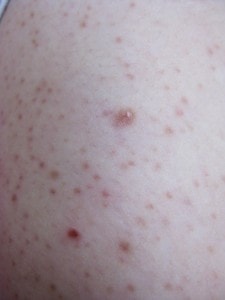 Scabies is a skin condition that is caused by mites that tunnel into the top layer of human skin. The skin reacts to the mite’s presence and develops a rash. Scabies do not discriminate: anyone can get them. And the little bugs are resilient and can live two to three days without any human contact. Those who live in group settings – like dormitories and nursing homes – need to be extra vigilant as these mites can be easily transferred from one person to another both directly (skin-to-skin contact) and indirectly (contact with linens and other items that have mites in them).
Scabies is a skin condition that is caused by mites that tunnel into the top layer of human skin. The skin reacts to the mite’s presence and develops a rash. Scabies do not discriminate: anyone can get them. And the little bugs are resilient and can live two to three days without any human contact. Those who live in group settings – like dormitories and nursing homes – need to be extra vigilant as these mites can be easily transferred from one person to another both directly (skin-to-skin contact) and indirectly (contact with linens and other items that have mites in them).
A dermatologist can tell pretty quickly if a person has scabies with a look at the affected area and a double check with a microscope with a skin sample. After a diagnosis, there are many types of treatment that can be used on scabies effectively. It is also necessary for anyone in the same household or who has had a good amount of direct contact with the affected person.
For most cases of scabies, topical treatments are sufficient. These will come in one of the following varieties: permethrin cream, benzyl benzoate lotion, sulfur ointment, crotamiton cream, and lindane lotion. These are antiparasitic agents that work in a variety of ways. Permethrin paralyzes and kills mites. Like most topical medications for skin conditions, its applied and left on (usually overnight), and later washed off. Lindane lotion overstimulates the mites’ nervous system, causing seizures and resulting in death. Unlike permethrin, it is not safe for children due to the much higher rate of absorption. Benzylee benzoate is another mite neurotoxin that is widely used in Europe and much less so in the US.
For those with severe cases or crusted scabies, it may be necessary to take ivermectin orally. These treatments are prescribed, so seeing a doctor for the correct dose and safe directions for use is critical, particularly when treating small children or those with other illness (particularly those with HIV status). In addition to these treatment, other treatments may be prescribed by a dermatologist to help control the symptoms. Antihistamines, pramoxine lotion, antibiotic, and steroid creams can all be helpful in alleviating symptoms. Multiple rounds of treatment may be necessary for heavy infestations.
Like with many other forms of very minor skin conditions, there are at-home and non-medical treatments that can be used to positive effect. Cayenne pepper, tiger balm, anise seed oil, neem oil, clove oil, rosemary oil, and tea tree oil are all topical household treatments that can alleviate symptoms of itching. Topical sulfur is the oldest known treatment, though no forms of this are FDA-approved currently. However, these treatments carry risks especially for those with sensitive skin or allergies. It is always recommended to check with your medical providers – including your dermatologist – before trying any new treatment.
Scabies is a very treatable skin condition and no one should be embarrassed about getting treatment for it. Luckily, there are many options for effective treatment and it can be cleared up within a few weeks.
(Source: American Academy of Dermatology)
Disclaim: This blog provides general information and discussion about medical, cosmetic, mohs, and surgical dermatology. The words and other content provided in this blog, and in any linked materials, are not intended and should not be construed as medical advice. If the reader or any other person has a medical concern, he or she should consult with an appropriately-licensed dermatologist or other health care worker.